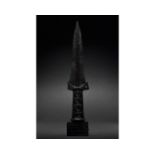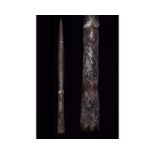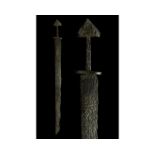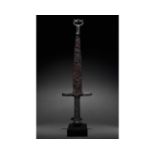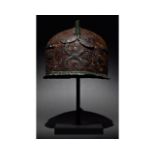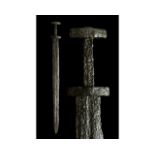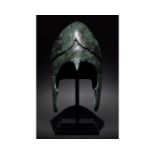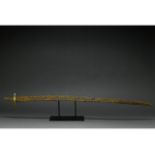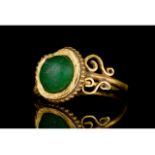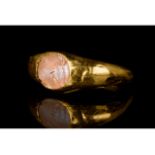Refine your search
Estimate
Category
- Arms, Armour & Militaria (102)
- Jewellery (80)
- Greek, Roman, Egyptian & Other Antiquities (54)
- Sculpture (35)
- Chinese Works of Art (25)
- Collectables (19)
- Glassware (15)
- Books & Periodicals (14)
- Scientific Instruments (14)
- Ceramics (11)
- Models, Toys, Dolls & Games (7)
- Taxidermy & Natural History (6)
- Coins (4)
- Vintage Fashion (4)
- Stamps (3)
- Metalware (2)
- Textiles (2)
- Bank notes (1)
- Furniture (1)
- Kitchenalia (1)
- Oil, Acrylic paintings & Mixed Media (1)
- Russian Works of Art (1)
- Salvage & Architectural Antiques (1)
- Silver & Silver-plated items (1)
- List
- Grid
A subscription to the Price Guide is required to view results for auctions ten days or older. Click here for more information
Ca. 900 AD. Viking Age. A rare silver necklace made of a single string of oval silver beads decorated with a dotted pattern. The necklace also com...
Ca. 1360-1410 AD. Medieval Western Europe. A stunning, forged-iron long sword of the Oakeshott Type XVa.6 with a long hilt and a deep wheel pommel...
Ca. 1410-1510 AD. Medieval Western Europe. A stunning, forged-iron long sword of the Oakeshott Type XVIIIa with a slender hand guard, a discoid po...
Ca. 1300-1400. Medieval Central European. A rare conical iron helmet with an extended chainmail neck guard. The original chainmail, attached to th...
Ca. 200-400 AD. Late Roman. A beautiful legionary sword of the 'spatha' type. This broad parallel-sided spatha has a convergent tip and a rectangu...
Ca. 800-600 BC. Cimmerian. A stunning bronze dagger finely cast in one piece with a tapering double-edged, slightly curved blade with a three-row ...
Ca. 1000-1200 AD. Viking. A fine forged-iron spearhead from Viking-era Europe with a long conical socket decorated with silver inlays in a lozengi...
Ca. 900-1000 AD. Viking. A beautifully preserved iron sword of the Petersen Type X style, with a double-edged bevelled, pointed blade and wide sha...
Ca. 900-1100 AD. Viking. A stunning single-edged iron sword with a long, double-edged blade, culminating in a point, a short, tapering guard, and ...
Ca. 200-400 AD. Late Roman. A beautiful legionary sword of the 'spatha' type. This broad parallel-sided spatha has a convergent tip and a rectangu...
CRUSADERS PERIOD IRON SWORD
Ca. 1100-1400 AD. Crusader Period. A beautiful iron sword with a long, bevelled blade, short guard, and long, two-handed grip, terminating a hemis...
Ca. 900-1100 AD. Viking. A conical iron helmet with small hinged cheek pieces and an extended chainmail neck guard. The original chainmail is atta...
Ca. 900-1100 AD. Viking. An impressive iron axehead with a curved blade and elliptical shaft-hole. The profile is square at the lower edge in the ...
Ca. 1360-1390 AD. Medieval Western Europe. A stunning, forged-iron long sword of the Oakeshott Type XVII.2 with a long hilt and a deep wheel pomme...
Ca. 1200-1300 AD. Medieval Western Europe. A stunning, forged-iron long sword of the Oakeshott Type XIII.1 with a long hilt and a flat disc pommel...
Ca. 1270-1340 AD. Medieval Western Europe. A beautiful forged Oakeshott type XIV longsword with a short handle and flat disc pommel. The cross is ...
Ca. 1257-1340 AD. Medieval Western Europe. A beautiful forged Oakeshott type XIV.1 longsword with a short grip and a broad and flat pommel. The cr...
Ca. 500-300 BC. Greek. A striking Chalcidian helmet made of hammered tinned bronze, with a sharply flaring neck-guard, a short slender nose guard ...
Ca. 1257-1340 AD. Medieval Western Europe. A beautiful forged Oakeshott type XIV.9 longsword with a short grip and a flat disc pommel with inlaid ...
Ca. 1300-1350 AD. Medieval Western Europe. A beautiful forged Oakeshott type XIIa.1 longsword with a short grip and a flat disc pommel. The crossg...
Ca. 600-400 BC. Scythian. A rare bronze dagger with a long, thin blade and a guard, the hilt ending in an ovoid transition type pommel. The guard/...
Ca. 500-300 BC. Greek. A beautiful example of a Chalcidian helmet. The stylised and ornately decorated bowl is forged in one piece and embossed wi...
Ca. 300 BC-100 AD. Celtic. Western European. A rare and superbly preserved Celtic iron and bronze helmet. The helmet has a hemispherical one-piece...
Ca. 1250-1350 AD. Medieval Western Europe. A stunning, forged-iron long sword of the Oakeshott Type XIIa.4 with a long hilt and a flat disc pommel...
Ca. 1000-1200 AD. Northern European. A beautiful forged Oakeshott type Xa longsword with a short grip and a disc-shaped pommel. The cross is lenti...
Ca. 1250-1370 AD. Medieval Western Europe. A beautiful forged Oakeshott type XIIIa longsword with a long grip and a disc-shaped pommel with a rece...
Ca. 900-1100 AD. Viking. A beautifully preserved iron sword with a double-edged bevelled and pointed blade and wide shallow groove; short guard an...
Ca. 1000-800 BC. Celtic. A stunning bronze leaf-shaped dagger with a rounded handle. The bronze has blued with age and has a superb patina. Bronze...
Ca. 900-700 BC. Koban-Caucasian Culture. A very rare bronze axe, richly decorated with geometric ornaments on the crescentic blade and a range of ...
Ca. 500-300 BC. Greek. A beautiful example of a Chalcidian helmet. The bowl is forged in one piece, featuring high-arched eyebrows below a peaked ...
Ca. 500-300 BC. Greek. A superb Chalcidian helmet. The bowl is forged in one piece, featuring high-arched eyebrows with an ear drop-shaped nose gu...
Ca. 1250-1400 AD. Medieval Western Europe. A beautiful forged Oakeshott type XIIa longsword with a long grip ending in a short bar. The cross is l...
Ca. 900-1100 AD. Viking. A beautifully preserved iron sword with a double-edged bevelled and pointed blade and a wide shallow groove; short guard,...
Ca. 450-100 BC. La-Tene culture. A long iron sword with a pointed, bevelled blade, and a long tang for inserting a handle onto the blade. Iron wea...
Ca. 400-600 AD. Migration Period. A long iron sword with a long, pointed, bevelled blade, a rectangular guard and a rectangular tang for insertion...
Ca. 400-600 AD. Migration Period. A long iron sword with a long, pointed, bevelled blade, a rectangular guard, and a rectangular tang for insertio...
Ca. 200-400 AD. Late Roman. A wearable gold ring with an applied Roman oval bezel set with a cabochon garnet gem and a possibly later circular ban...
Ca. 500-400 BC. Phoenician. A beautiful Phoenician faience gem portraying a female figure set into a later gold ring with an oval bezel, a circula...
Ca. 200-400 AD. Late Roman. A wearable gold ring with a thin circular band, shoulders decorated with two bands of double wires, and a round bezel ...
Ca. 800-1000 AD. Viking. A beautiful silver Mjölnir ("Lightning," Thor's mighty hammer) pendant of extraordinary size with gold inlays. The gold i...
Ca. 500-600 AD. Western Europe, Merovingian, Migration Period. A set of beautiful gilded bronze belt fittings, usually held to the leather strap w...
Ca. 568-800 AD. Caucasus. A set of Avar silver belt fittings in different shapes and forms, such as buckles and belt plates. Good condition. Most ...
Ca. 900-1000 AD. Viking. A very large silver filigree necklace with five lunar crescent pendants. Granulated silver forms the symmetrical swirls a...
CELTIC IRON AGE BRONZE TORC
Ca. 300-100 BC. Celtic. A beautiful Iron Age bronze torc in the shape of a crown. Excellent condition. Commonly mentioned as spoils of war and usu...
Ca. 900-700 BC. Koban-Caucasian Culture. A beautiful incense burner in the shape of four rams. The animals, standing on their front legs, are faci...
Ca. 800-600 BC. Bronze Age. A beautiful bronze necklace made of numerous stylized mace-head pendant amulets and beads of various sizes and shapes....
Ca. 800-600 BC. Bronze Age. A beautiful bronze necklace made of numerous stylized mace-head pendant amulets with bronze and stone beads in a red p...
Ca. 200-400 AD. Roman. A gold necklace with a gold chain made of small figure of eight parts and a gold pendant, ellipsoidal in cross-section, in ...
Ca. 100-300 AD. Roman. A beautiful, wearable gold bracelet composed of solid ovoid gold beads and a round bezel with blue inlay. Both terminals ar...
Ca. 100-300 AD. Roman. A beautiful gold bracelet with a gold chain made of small figure of eight parts, a hook clasp, and a round gold pendant wit...
Ca. 200-400 AD. Late Roman. A beautiful gold ring with a circular band made of coiled beaded wires, flared shoulders, and a round bezel with blue ...
Ca. 100-300 AD. Roman. A beautiful gold ring with a circular band, flared shoulders, and bezel decorated finely incised intaglio depicting a scene...
Ca. 900-1000 AD. Viking. A stunning silver filigree pendant in a woven, abstract form with a stylized face at the top. Granulated silver forms the...
Ca. 900-1100 AD. Viking. A stunning silver pendant in the shape of a Mjölnir (Thor's hammer) decorated with typical engraved triangular marks, eac...
Ca. 900-1100 AD. Viking. A stunning silver pendant in the shape of a Mjölnir (Thor's hammer) decorated with three circles and notches above and be...
Ca. 1000-1300 AD. Holy Lands. A beautiful Crusaders or Seljuk gold ring with a circular hoop, flared shoulders with central raised ridge, and rais...
Ca. 100-300 AD. Roman. A wearable gold ring with a circular band, gently flared shoulders, and applied oval bezel set with a cabochon purple gem. ...
Ca. 500-700 AD. Western Europe, Merovingian, Migration Period. A beautiful moon-shaped gold fitting with inset garnets. Good condition. At the tim...
Ca. 600-400 BC. Scythian. A beautiful gold and rock crystal amulet in the shape of a tube with ribbed gold ends and a ribbed central section; atta...
Ca. 100-200 AD. Roman. A striking pair of matching heavy gold earrings, each composed of a curved thick band of gold and with applied granulated p...







